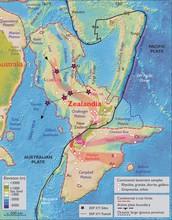Lost continent of Zealandia: Scientists return from expedition to sunken land

Where were the scientists heading? A map shows the once-lost continent of Zealandia. Credit: IODP
After a nine-week voyage to study the lost, submerged continent of Zealandia in the South Pacific, a team of 32 scientists from 12 countries has arrived in Hobart, Tasmania, aboard the research vessel JOIDES Resolution.
Researchers affiliated with the International Ocean Discovery Program (IODP) mounted the expedition to explore Zealandia. IODP is a collaboration of scientists from 23 countries; the organization coordinates voyages to study the history of the Earth recorded in sediments and rocks beneath the seafloor.
“Zealandia, a sunken continent long lost beneath the oceans, is giving up its 60 million-year-old secrets through scientific ocean drilling,” said Jamie Allan, program director in the U.S. National Science Foundation's Division of Ocean Sciences, which supports IODP.
“This expedition offered insights into Earth's history, ranging from mountain-building in New Zealand to the shifting movements of Earth's tectonic plates to changes in ocean circulation and global climate,” Allan said.
Earlier this year, Zealandia was confirmed as Earth's seventh continent, but little is known about it because it's submerged more than a kilometer (two-thirds of a mile) under the sea. Until now, the region has been sparsely surveyed and sampled.
Expedition scientists drilled deep into the seabed at six sites in water depths of more than 1,250 meters (4,101 feet). They collected 2,500 meters (8,202 feet) of sediment cores from layers that record how the geography, volcanism and climate of Zealandia have changed over the last 70 million years.
According to expedition co-chief scientist Gerald Dickens of Rice University in the U.S., significant new fossil discoveries were made. They prove that Zealandia was not always as deep beneath the waves as it is today.
“More than 8,000 specimens were studied, and several hundred fossil species were identified,” said Dickens.
“The discovery of microscopic shells of organisms that lived in warm shallow seas, and of spores and pollen from land plants, reveal that the geography and climate of Zealandia were dramatically different in the past.”
The new discoveries show that the formation 40 to 50 million years ago of the “Pacific Ring of Fire,” an active seafloor zone along the perimeter of the Pacific Ocean, caused dramatic changes in ocean depth and volcanic activity and buckled the seabed of Zealandia, according to Dickens.
Expedition co-chief scientist Rupert Sutherland of Victoria University of Wellington in New Zealand said researchers had believed that Zealandia was submerged when it separated from Australia and Antarctica about 80 million years ago.
“That is still probably accurate, but it is now clear that dramatic later events shaped the continent we explored on this voyage,” Sutherland said.
“Big geographic changes across northern Zealandia, which is about the same size as India, have implications for understanding questions such as how plants and animals dispersed and evolved in the South Pacific.
“The discovery of past land and shallow seas now provides an explanation. There were pathways for animals and plants to move along.”
Studies of the sediment cores obtained during the expedition will focus on understanding how Earth's tectonic plates move and how the global climate system works. Records of Zealandia's history, expedition scientists said, will provide a sensitive test for computer models used to predict future changes in climate.
Media Contact
All latest news from the category: Earth Sciences
Earth Sciences (also referred to as Geosciences), which deals with basic issues surrounding our planet, plays a vital role in the area of energy and raw materials supply.
Earth Sciences comprises subjects such as geology, geography, geological informatics, paleontology, mineralogy, petrography, crystallography, geophysics, geodesy, glaciology, cartography, photogrammetry, meteorology and seismology, early-warning systems, earthquake research and polar research.
Newest articles

Innovative vortex beam technology
…unleashes ultra-secure, high-capacity data transmission. Scientists have developed a breakthrough optical technology that could dramatically enhance the capacity and security of data transmission (Fig. 1). By utilizing a new type…

Tiny dancers: Scientists synchronise bacterial motion
Researchers at TU Delft have discovered that E. coli bacteria can synchronise their movements, creating order in seemingly random biological systems. By trapping individual bacteria in micro-engineered circular cavities and…

Primary investigation on ram-rotor detonation engine
Detonation is a supersonic combustion wave, characterized by a shock wave driven by the energy release from closely coupled chemical reactions. It is a typical form of pressure gain combustion,…



